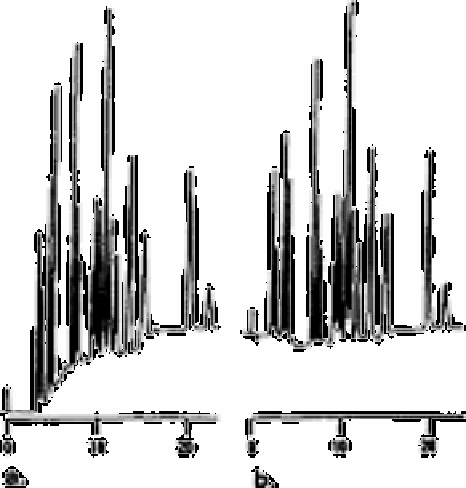Chemistry Reference
In-Depth Information
Fig. 12.20. In practice, this is not straight-forward because equation (1) assumes that a
single linear gradient is used with the initial eluant concentration equal to zero. Faster
gradient runs can be obtained by starting the eluant concentration at a higher value. Also,
the best combination of speed and selectivity is often the result of combining several
different gradients, often with isocratic sections and step changes. With more
complicated gradient programs, the retention equation becomes unwieldy.
Equation (1) can be easily used to predict trends. This is demonstrated in Fig. 12.21. In
all three chromatograms, the initial eluant concentration is 2.5mM
p
-cyanophenate. This
concentration is increased between 2 and 7min to 18.5mM in (a) (where sulphate and
nitrate co-elute) to 22.5mM in (b), resulting in baseline separation. In (c), the eluant
concentration is increased as in (a) to 18.5mM, but in 5min. instead of 9min. The effect is
similar in that the divalent anions elute earlier, but because of the long period holding at
18.5mM, the separation between the divalent anions is not compressed as in (b), but is
instead similar to (a). The chromatogram in Fig. 12.18 of anions on the HPIC-AS6 was
developed with this method and uses a combination of step changes, linear gradients and
isocratic sections.
Fig. 12.22
Balancing the gradient baseline with (a) mannitol and (b) boric acid
AS6,
p-
cyanophenate eluant
Source: Reproduced with permission from Dionex Corporation [24]
When eluants other than sodium hydroxide are used, it is often necessary to minimise the
baseline slope which results as the eluant concentration is increased. In anion exchange,
this can be accomplished chemically by adding mannitol to the weak eluant and boric
acid to the regenerant. Although the reaction between boric acid and mannitol is not well

Search WWH ::

Custom Search